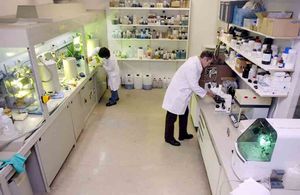uv reactors, photo-oxidation, advanced oxidation (aop), recycling & engineering
for industrial use
UV-Oxidation
Photo-Oxidation
Our UV Oxidation Processes
We combine a completely new and state-of-ther-art UV technology for photo-oxidation with additional chemical and physical process steps to form an innovative unit. In doing so, we extend UV technology into new fields, which were previously thought to be uneconomical. A concept based on the system as a whole and the integration of different process steps into a master process – that is what makes up the advanced oxidation technology (AOT) by enviolet.
We are constantly developing new recipes and processes in order to economically develop further fields of application for UV oxidation and AOP (Advanced Oxidation Process). The integration of oxygen in the oxidation reactions plays a central role, with the formation of singlet oxygen also being desirable in certain reaction stages.
UV oxidation processes are very sustainable and climate-friendly processes, particularly in the wastewater treatment of organic ingredients. With UV oxidation, problematic substances are actually removed and finally destroyed. The UV oxidation can transform toxic, mutagenic or poorly degradable substances in such a way that they are oxidized in the flowing phase so that they are completely degraded or are prepared for further biological oxidation. Biological treatment is then part two of the environmentally friendly solution. Such processes target the pollutant and degrade it sustainably with a minimal CO2 footprint.
Wastewater treatment processes such as evaporation or separation processes such as membrane technology enrich the problematic substance in a concentrate phase and usually require more energy than AOP oxidation, which completely eliminates the pollutant with less energy. Often a lot of energy (= CO2) is used for evaporation and the concentrate has to be burned afterwards. In this context, incineration always means sending the waste water through a flame (auxiliary firing) and converting the accompanying water into steam and burning the pollutant in the gas phase formed in this way at high temperatures. Afterwards, additional exhaust gas treatment processes are required in order to comply with the BImSch. All of this requires a multiple of energy and CO2. But even if the auxiliary firing were maintained with hydrogen after decarbonisation of the economy, it would still be not very intelligent to generate electrical energy from wind power and generate H2 from it to burn wastewater, instead of a fraction of the electrical wind energy directly into the UV oxidation of the AOP process to get stuck. The AOP process is also usually much cheaper because the conservation of resources is reflected in lower operating costs: less energy, fewer raw materials, ... usually also means lower costs.
A process for wastewater treatment can therefore be massively optimized in terms of its CO2 balance by integrating an enviolet system and make a major contribution to climate-neutral production. Many of our customers are already proud of this and explicitly state this.
enviolet stands for a real solution in the fight against climate change and not for the transfer of problems in wastewater treatment to incineration!
Development of our AOP and UV Oxidation Processes

We apply the turn-key unit for elimination of contaminats based on our extensive experience in oxidation processes: We take care of everything from process design, production, build, commissioning, start-up and maintenance, for you to retain a well-designed oxidation plant, which highest oxidation efficiency.
We put together the right process steps for oxidation, make-up or pre-treatment in our application lab and find the right parameters to create a satisfying oxidation and treatment solution for you. All of this is done based on our long experience in advanced oxidation and the R&D work in our application laboratory. With different lab, technical scale and pilot units, and our huge pool of AOP-installations with many different oxidation processes we can apply your process under most reliable and optimum conditions.
Our aim: a reliable process with transparent costs for the client.Where possible, we also use the oxidation power of singulett oxygen.
For standard applications for degradation of chemical contaminats in clean processes, we typically do not require further testing of related treatment processes.
On the other hand we also supply the full service for process development for the oxidation and degradation of pollutants: from lab scale (5 L) to full scale application (240 to/d).
Chemical Processes during the Reactions

Photo-Oxidation in presence of oxygen regularly leads to formation of reactive singlett oxygen. Enviolet provides most efficient oxidations-processes, especially in case of high concentrations of contaminats and matrix.








